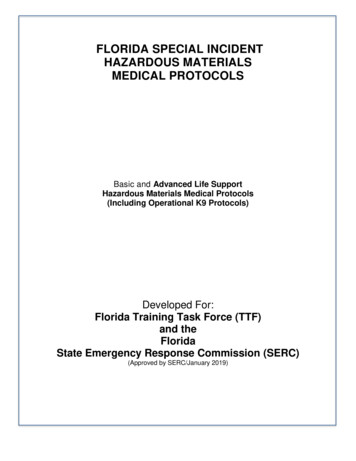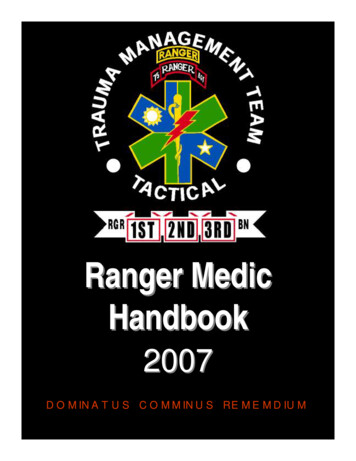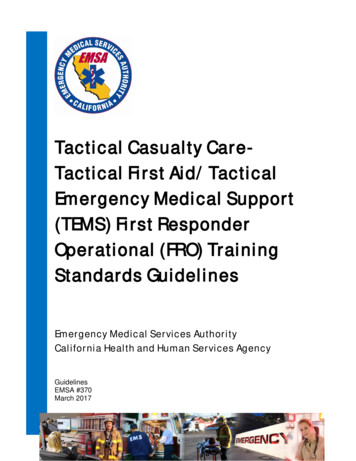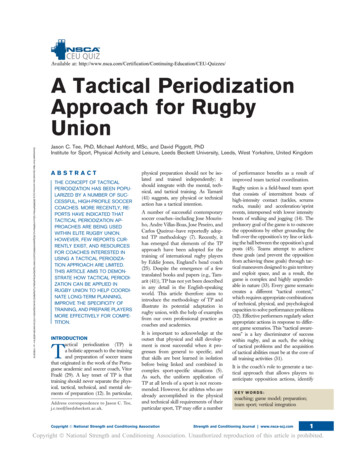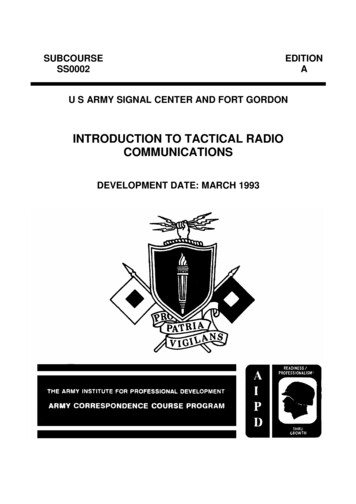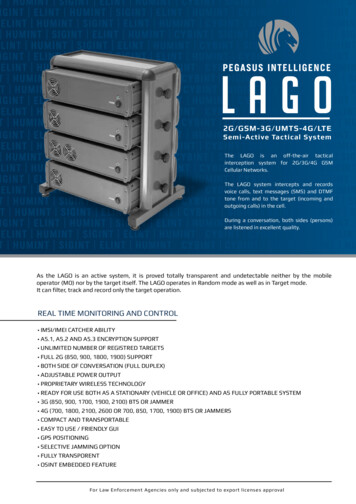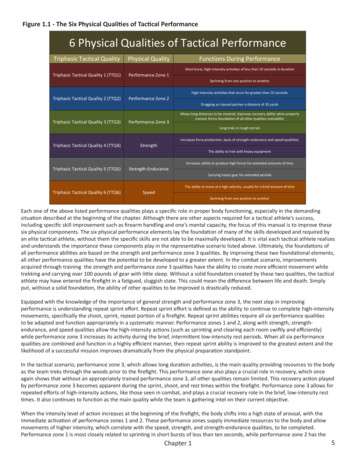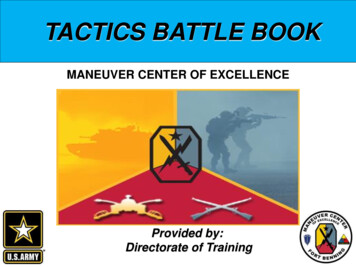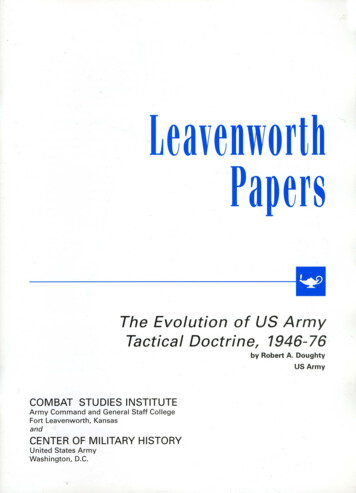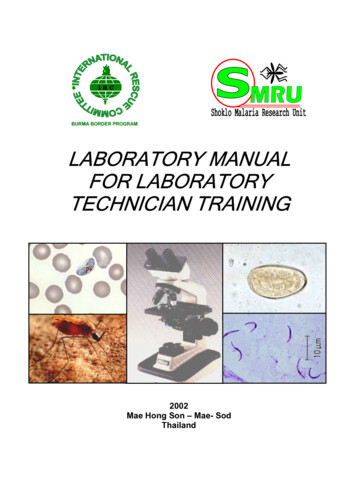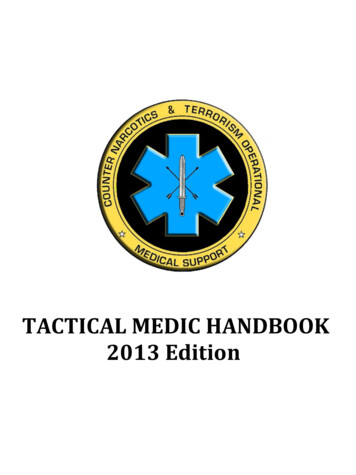
Transcription
TACTICAL MEDIC HANDBOOK2013 Edition
TACTICAL MEDIC HANDBOOK2013 EditionTable of ContentsAcknowledgements7Part 1: OverviewDefinitionsGeneral ConsiderationsGeneral Approach to Patient Care9WhitePart 2: CONTOMS TEMS ProtocolsX Exsanguinating HemorrhageExsanguinating HemorrhagePurpleA AirwayAirway Obstruction/ChokingAllergy/AnaphylaxisC-Spine InjuryLt. BlueB BreathingRespiratory Distress with BronchospasmPulmonary EdemaRespiratory ArrestTension PneumothoraxOpen Chest WoundBlueC CirculationChest Pain (Suspected Cardiac Origin)Cardiac ArrestCardiac Arrest with HypothermiaCardiogenic ShockDehydrationHypovolemic ShockRedD1 Defibrillation/DysrhythmiaAutomatic External Defibrillator (AED) UsePulseless Arrest AlgorithmBradycardia/ Heart Blocks AlgorithmTachycardias 859606162
D2 Decontamination/Drugs (Toxicology)Toxins: GeneralIngested ToxinsInhaled ToxinsAbsorbed Toxins/Contact ExposuresInjected ToxinsTricyclic Antidepressant OverdoseNarcotic OverdoseOrganophosphate/ Carbamate PoisoningCyanide PoisoningOrange636464656566676869D3 DeficitYellowAltered Mental Status-Not CombativeAltered Mental Status-Combative R/O Excited Delirium SyndromeHead TraumaDiabetic EmergencySeizures7071737475E Extremity and EnvironmentAmputationsCrush SyndromeSnakebitesCold Injury (Hypothermia)Heat Injury (Heat Exhaustion/Heat Stroke)Drowning and Near DrowningDecompression IllnessMarine EnvenomationBurnsAltitude IllnessInsect BitesGreen7677798183848586899192F FetusEmergency ChildbirthNeonatal ResuscitationBrownGeneral ProtocolsBasic Wound CarePain ManagementClearance for IncarcerationLess Lethal Kinetic Impact MunitionsLess Lethal Conducted Energy WeaponsLess Lethal Chemical MunitionsBlast InjuryDental Field CareHIV Post-Exposure ProphylaxisTan9495969798100101102103104107
PediatricPediatric Normal Vital SignsPediatric Airway StridorPediatric Respiratory DistressPediatric Respiratory ArrestPediatric Cardiac ArrestPediatric ShockPediatric Altered Mental StatusPediatric SeizuresGrayK-9 Emergency CareK-9 Baseline Screening ExamK-9 First AidK-9 Procedure SitesGoldReferenceNon-EMS System Medical IntervenersGlascow Coma Scale (GCS)Provider Scope of Training 123Part 3: TEMS KITS Sample Packing Lists1271. Saline Lock Kit2. IV Kit3. Minor Wound Kit4. Major Wound Kit5. TacMedic Vest Kit6. TacMedic Primary Aid Bag (M-5 Bag)7. Resuscitation Kit8. TacMedic Controlled Drug Kit9. Sick Call Box (M-15 Box)10. Oxygen Kit11. Special Event Pack (SEP)12. Personnel Bag13. K-9 Down ical Protocol Index143
Disclaimer:These guidelines were developed as a reference for the CounterNarcotics and Terrorism Operational Medical Support (CONTOMS)Program. The guidelines and protocols provided in this manual arebased on the most current information available at the time ofpublication. Every effort has been made to ensure the accuracy of thisinformation, but the CONTOMS Program cannot be responsible fordiscrepancies or typographical errors. Since medical practice iscontinually evolving, providers are reminded to remain cognizant ofthe most current practices that may revise or replace the approachadopted in this publication. Providers are also cautioned not to rely onthis manual as a sole source of information about patient care, butrather to tailor their therapy to the clinical context and to consultmedical control for any concerns.6
AcknowledgementsThe CONTOMS Program would like to acknowledge the followingindividuals for their contributions to this edition:Craig Llewellyn MD MPHBryan Fisk MDDenis FitzGerald MDRick Hammesfahr MDAndrew Harrell MDDavid Tan MDEdward Otten MDMatthew Sztajnkrycer MD PhDThomas Janisko PA-CKevin Parker EMT-PGregory Smith EMT-BRobert Hunt EMT-PPaul Hitchcock EMT-PWarren Templeton EMT-PKenneth Traylor EMT-BThe following works were referenced in the development of thisManual: Tactical Combat Casualty Care GuidelinesUS Special Operations Command Tactical Medical EmergencyProtocolsTintinalli’s Emergency Medicine7
8
Part 1: Overview9
Definitions:ACLS—the American Heart Association’s Advanced Cardiac Life Support Course.Advanced airway—specialized and more invasive procedures, other than manual airway skills andoropharyngeal/nasopharyngeal airways, such as rescue airways, orotracheal and nasotracheal intubation,direct laryngoscopy, digital intubation, and surgical airway, performed only by those who have completedpractical training in each of these skills and have the skills within their scope of practice.AED—semi-automatic external defibrillation (or defibrillator).AGE—arterial gas embolism.AHA—the American Heart Association.ALS—advanced life support.AVPU—a mnemonic for assessment of mental status, consisting of: alert, responsive to verbal stimuli,responsive to painful stimuli, and unresponsive.BLS—basic life support.BP—blood pressure.BPM—beats per minute.BSA—body surface area.Burn center—a medical care facility designated to care for severely burned patients.BVM—bag-valve-mask.CHF—congestive heart failure.CN—cranial nerve; chloroacetophenone (tear gas).CS—orthochlorobenzalmalonitrile (an irritant used for riot control).C-spine—cervical spine.Combat Pill Pack (CPP) —individual pack of medications (analgesic and antibiotic) to be given in theevent of injury.CONTOMS— Counter-Narcotics and Terrorism Operational Medical Support Program.CVA—cerebrovascular accident or stroke.DCS I, DCS II—decompression sickness types I and II.DNR (Do Not Resuscitate)—a legal document that expresses the patient’s wish to decline heroic, lifesaving measures in the event that his or her condition deteriorates to a life-threatening level.D5W—5% dextrose in water.D50—50% dextrose solution.Emergency medical services (EMS)—community-based advanced life support (ALS) and/or basic lifesupport (BLS) services that respond to provide local out-of-hospital emergency care.Emergency Medical Technician—Tactical (EMT-T)—an individual certified as an EmergencyMedical Technician–Tactical (EMT-T) through the Counter-Narcotics and Terrorism Operational MedicalSupport (CONTOMS) Program.EMS provider—any person or service authorized by a local, regional, or national body to provideemergency medical service.EMT-B—Emergency Medical Technician-Basic, as recognized by the National Registry of EmergencyMedical Technicians.EMT-I—Emergency Medical Technician-Intermediate, as recognized by the National Registry ofEmergency Medical Technicians.EMT-P—Emergency Medical Technician-Paramedic, as recognized by the National Registry ofEmergency Medical Technicians.ET—endotracheal.ETT flush—a bolus of IV fluid (3–5 mL for pediatric patients; up to 10 mL for adults) administered viathe endotracheal tube following ETT administration of medications. Use of the ETT for medication10
administration is to be considered a temporary route; IV or IO access should be secured as soon aspossible.Excited Delirium Syndrome (ExDS)—a condition that manifests as a combination of altered mental status,psychomotor agitation, anxiety, hallucinations, speech disturbances, violent and bizarre behavior,insensitivity to pain, elevated body temperature and superhuman strength.Fluid challenge—the rapid administration of 500 mL of IVF as a bolus in order to improve the patient’shemodynamic parameters.GCS—Glasgow Coma Scale.Greater than/less than—are indicated by “ ” meaning “greaterthan” and “ ” meaning “less than.” Example: “BP 90 mm Hg” means “BP less than 90 mm Hg.”HEENT—head, eyes, ears, nose, and throat.HR—heart rate.Immobilize—means to temporarily splint a body part or limb using mechanical or traction devices toprevent the body part from moving. Immobilization accomplishes its task without assistance.IFAK—Individual First Aid Kit.IO—intraosseous. Used to refer to administration of fluids and/or medications via IO access. For pediatricand adult patients, IO access may be used for temporary access if an IV is not established within 90seconds or after three attempts. IO access should only be used when the patient is unstable or theestablishment of parenteral access is deemed essential for patient care.IV—intravenous. IV access is used to administer any balanced electrolyte solution, such as lactatedRinger’s or normal saline and/or medications. Optimal catheter size for rapid fluid resuscitationin adults is 14–16 gauge/1-inch length. If rapid fluid resuscitation is not required, smaller catheter sizes orheparin/ saline locks may be used. Heparin used for this procedure is not considered a medication.IVF—intravenous fluids.IVP—intravenous push of medications.KVO—using the minimal intravenous fluid rate necessary to “keep vein open.”LEA—law enforcement agency.LR—lactated Ringer’s intravenous solution.Medical control—supervisory guidance and direction for the medical skills performed by TEMS medic.Medical director—a physician who supervises the clinical care of the TEMS medical program.Medic—medical personnel who are authorized to operate under these protocols by their agency.Medical program coordinator—a LEA designee charged with coordination and liaison among staff, themedical director, and LEA personnel.MI—Myocardial Infarction or heart attack.NC—nasal cannula.NPA—nasopharyngeal airway.NRB—non-rebreather oxygen mask.NS—normal saline intravenous solution.OC—oleoresin capsicum (used as an irritant in pepper spray).Official in charge (OIC)—the senior law enforcement person in charge of a given mission to which anTEMS medic is assigned.Online medical control (OLMC)—the online (meaning in direct communication with field providers)physician or physician designee, affiliated with a bona fide federal/local/regional EMS system, whoaccepts responsibility for a specific patient and for directing the actions of pre-hospital EMS personnelconsistent with these protocols.OPA—oropharyngeal airway.Pediatric patient—in these protocols, means a patient who has not yet reached puberty (i.e., a patientwithout breast development or pubic, axillary, or facial hair).PO—orally.11
PPE—Personal Protective Equipment, such as gloves and masks.PPV—positive pressure ventilation such as: (1) mouth-to-mask ventilation with oxygen; (2) two-personbag-valve-mask technique with oxygen; (3) flow-restricted oxygen-powered ventilation device; or (4) oneperson bag-valve-mask technique with oxygen.Practical area of responsibility—the geographical area within which the TEMS medic might bereasonably expected to provide service. In some cases, this may be well defined as a region, field division,or some other organizational element. In other cases, the medic may have national or globalresponsibilities and may be unable to preplan local medical resources.Rescue Airway- Extraglottic/Supraglottic airway management tools including Laryngeal Mask AirwaySupreme (LMAS), Combitube and King LT-D GE—the toxidrome associated with organophosphate/carbamate (chemical nerve agent/pesticide)poisonings, consisting of: salivation, lacrimation, urinary incontinence, defecation, gastric cramping, andemesis.Stabilize—hold a limb or body part in a stable position and prevent inadvertent movement. Stabilizationis used until immobilization can be achieved through splinting.TEMS – tactical emergency medical support.Trauma center—refers to a medical facility designated by the EMS system as being specially staffed andequipped to manage trauma patients.VF—ventricular fibrillation.VT—ventricular tachycardia.XABCs—exsanguinating hemorrhage, airway, breathing, and circulation.12
General Considerations1. Introduction1.1. The out-of-hospital emergency care protocols in this manual were prepared by the CONTOMSProgram for Tactical Medical Support (TEMS). These protocols reflect current treatmentmethodologies for the management of adult and pediatric patients in an emergency encountered in thetactical environment.1.2. In general, protocols are not absolute and ultimate treatment doctrine. They serve as guidelines forthe range of problems the TEMS medic may encounter. Patients often do not fit into a standardpresentation and there is no substitute for good clinical judgment. Within the framework of establishedprotocols, each medical provider must always ensure individualized treatment based on clinicaljudgment, the specific circumstances of care, and the provider’s level of training.1.3. All care rendered by TEMS medics is considered to be an extension of the medical director’sauthority to practice. As such, the medical director is responsible for directing all patient care bycovered TEMS personnel. This supervision is established through training, education, medicalprotocols, review of treatment records, and other quality improvement mechanisms. Occasionally, themedical director may also provide online direction to TEMS personnel.2. Scope of Practice2.1. For the purposes of these protocols, scope of practice shall be defined as those skills andprocedures outlined in these protocols for which the medic is appropriately trained. Medical providersmay perform only those skills for which they are trained and currently credentialed by medical control.2.2. Certain skills, other than those of a nationally or state certified Emergency Medical Technician(EMT), are authorized for TEMS medics acting within the scope of duty under certain specificconditions identified during training and falling within these protocols.2.3. If directed by an onsite physician or base station physician to perform a skill not included in themedic’s scope of practice, it is incumbent upon the TEMS medic to inform the physician of thelimitation and to agree upon an alternative patient treatment plan.3. Medical Control3.1. Online medical control exists when a direct link is established between the TEMS medic and aphysician to provide active consultation on patient treatment in progress.3.1.1. The physician may be located on scene, reached at a local base station, or contacted throughthe pre-established procedures.3.2. The medic should request appropriate verification of identity from any on-site physician. If thephysician is not acting as part of the local emergency medical services (EMS) system, then the TEMSmedic may exercise discretion in assuring that the physician can provide appropriate patient care in thatsetting.3.2.1. On-site physicians who assume medical control must agree to remain with the patient untilcare is transferred and must sign the patient treatment form.13
3.3. Any dispute between an on-site physician and the TEMS medic should be resolved by establishingonline communications with the medical director or a base station physician.3.4. Online medical control can provide consultation and direction of out-of-hospital care by TEMSmedics. The medical director, his or her designee, or a recognized base station physician operatingwithin an established EMS system shall perform online communications.3.5. TEMS medics shall honor online medical control as long as the orders are within their scope ofpractice. In the event TEMS medics are called upon to perform care outside of this scope of practice,they shall advise the physician that they are unable to comply with the order because it is outside theirscope of practice and training.3.6. Offline medical control is constantly and transparently in place through the definition of scope ofpractice, protocols, the quality improvement program, and other monitoring systems.4. Framework for TEMS Care Delivery4.1. Relationship of TEMS to Traditional Prehospital Care: Care of tactical trauma patients is not thesame as care of trauma patients in the secure environment. ATLS, BTLS, and PHTLS, while worthyprograms, were never designed for use in the hostile environment. In tactical medicine, care of thepatient must be modified to fit the threat environment. Many concepts in traditional EMS have beenmodified for the delivery of TEMS care.4.2 Relationship of TEMS to Military Medicine: The US military currently follows the TacticalCombat Casualty Care (TCCC) Guidelines. These guidelines divide care delivery into three phases:Care Under Fire, Tactical Field Care, Tactical Evacuation Care. Many practices in TEMS have beenderived from military medicine and adapted to the civilian environment.4.3 TEMS Phases of Care: In TEMS, care delivery is divided into three phases: hot zone care, warmzone care, and cold zone care. A synopsis of the type of care to be delivered in each phase is givenbelow. These procedures hold for TEMS only. Traditional civilian EMS assumes that all patients havea chance to survive. However, in law enforcement situations in which the rescuers’ lives are inimmediate danger, alternative standards of care are adopted.4.3.1 Hot zone care: Care given at the scene of injury while under a direct and immediatethreat such as effective fire. Highly limited care, the goal is to get the victim out of thefire zone without creating new casualties. Return fire as directed or required, if applicable. Keep yourself from being injured. Keep the victim from sustaining further injury. If possible, direct him to take cover and startself-aid. Stop any life-threatening hemorrhage with a tourniquet, if safe to do so, as described in theExsanguinating Hemorrhage Protocol on page Purple 42. Extract casualty with you when you leave.14
4.3.2 Warm zone care: Care given once the medic and the casualty are no longer under adirect and immediate threat, but some level of threat persists. This phase is when themajority of tactical medical decision making and TEMS care will take place. Address the XABCs, utilizing the TEMS Protocols in Part 2 of this manual.4.3.3 Cold zone care: Care given once there is no longer a threat. Care will usually involveaircraft, boat, or vehicle transport to an area where additional medical equipment maybe available. Standard Pre-hospital EMS Care. Continue treatment begun in the warm zone and monitor the patient. Document the care given and prepare to hand-off the casualty to the next echelon of medicalcare.4.4. Note: No handbook can anticipate every tactical and/or medical situation that may occur during arescue. When faced with an unusual situation, the TEMS medic will have to improvise, adapt, andovercome.5. Implied or Informed Consent5.1. Patients NOT in custody: Standard medical ethics and principles of law allow all patients of legalage and “sound mind” to consent to or refuse medical treatment. Therefore, the following guidelinesshall apply. All conscious patients shall be evaluated by TEMS medics for their competency to makedecisions concerning the need for emergency medical care. Conscious, rational patients notin custody shall be allowed to refuse care from TEMS medic personnel if they so choose. If a patient not in custody refuses out-of-hospital treatment for a condition that the TEMSmedic feels requires care, the patient shall be requested to sign the appropriate “Refusal ofCare” section of the patient treatment form and treatment at a medical facility will besuggested. If the patient refuses to sign the “Refusal of Care” section, this should be notedon the form and witnessed by a person other than the medic who is completing the form. Persons judged to be incompetent by the TEMS medic for medical decision making, or whoare unconscious, shall be treated under the implied consent doctrine.o A person believed to be under the influence of drugs or alcohol shall be consideredincompetent for the purposes of refusing emergency medical care.5.2. Patients in custody: Special care must be taken to ensure that persons who are in custody haveappropriate access to medical care and that the environment in which care is offered is not coercive orintimidating. All ill or injured persons under LEA control shall receive appropriate medical attentionand/or be medically cleared by a competent medical authority at some time during mission activities.Individuals refusing required medical care on scene by TEMS medics will be transported forindependent medical evaluation.6. Resuscitation Guidelines6.1. When to start resuscitation. As soon as the absence of pulse and/or respiration is established (unless a contraindicationin Section 6.2 is present)15
6.2. When not to start resuscitation (assuming a normothermic body). Any patient displaying obvious and accepted signs of irreversible death such as rigor mortis,dependent lividity, decapitation, decomposition, incineration, or other lethal injury. When an original, signed, physician’s Do Not Resuscitate (DNR) order is presented. (SeeSection 7). When the risks and costs of starting resuscitation clearly outweigh the potential benefits,given the totality of circumstances (e.g. mass casualty scenario where such patients wouldbe triaged as expectant or TEMS scenario where the risk to providers is too great to performCPR).6.3. When to stop resuscitation. When the patient regains pulse and respiration. When equally or more highly trained resources or health care personnel take over. When resources are physically exhausted. When the risks and costs of continuing resuscitation clearly outweigh the potential benefits,considering the totality of circumstances. When a patient’s personal physician or medical control orders resuscitation to stop. Contactmedical control for options to stop:o When the patient is unresponsive to ACLS protocols for 20 minutes.o In the absence of advanced cardiac life support, when the same TEMS medic hasdocumented the absence of all vital signs for 20 consecutive minutes, in spite of BLSmeasures, except in the case of hypothermia.6.4. Management of the Deceased6.4.1. If resuscitation efforts are discontinued, arrangements should be made with regard todisposition of the body. Consider potential forensic and evidentiary issues as well as local laws,since such disposition falls under the jurisdiction of the state within which the death occurred.7. Do Not Resuscitate (DNR) Program7.1. Most states have enacted some form of Do Not Resuscitate (DNR) legislation. DNR programsallow a patient who suffers from a terminal medical condition to establish a do not resuscitate request.This expresses, in a legal form, the patient’s wish to decline heroic life-saving measures in the eventthat they suffer respiratory or cardiac arrest. A patient has the right to verbally revoke a DNR order atany time. DNR orders must be sanctioned by a government body to be valid. In general, these ordersinclude the patient’s name, certification by a physician of the terminal condition, and verification by awitness that the DNR order is the patient’s wish. An identification card or bracelet may be issued by agovernmental authority in addition to the written order stating certification of these facts.7.2. TEMS medics may honor a state or governmentally established DNR program when the TEMSmedic can confirm that the presenting patient is in fact the patient for whom the DNR order was issued.7.3. If the TEMS medic can confirm the identity and validity of a DNR participant: Initiate a community EMS response if one is available. If no EMS is available, arrangeappropriate patient transportation. Limit patient care to noninvasive palliative measures to ensure patient comfort whileawaiting EMS response.16
7.4. If a valid DNR cannot be immediately confirmed, the TEMS medic shall begin to instituteappropriate resuscitative efforts and request a community EMS response.8. Documentation8.1. A patient treatment form must be completed for each patient examined or treated by the TEMSmedic. This report provides an organized record of the important facts of a patient’s presentation andtreatment.8.2. The patient treatment form should be prepared as soon as practical to document patient caredelivered. A copy of this report should be handed over at patient transfer, if possible. However, missionrequirements or patient condition may prevent immediate form completion. If care has been performed,a written patient report should be provided to the receiving facility as soon as practical.17
General Approach to the Patient CareMedical Pre-PlanBasic Tactical EmergencyMedical Support (TEMS)AlgorithmDetectTactical Scene SurveyYOUTactical SkillsEngageObserveSafeHavenThreatR- React to the ThreatE- Extract VictimS- Safe HavenC- Command and ControlU- Urgent CareE- Evacuate VictimR- ReassessSafe?TriageMedical SkillsDefinitive CareCLEAR the CasualtyGeneral Impression (Sick/Not Sick?)Tactical Primary Survey(XABCDEFG)Vital Signs (BP, P, R)Secondary Survey (SAMPLEHistory, H-T Exam)Assessment/PlanReassessment18
Medical Pre-plan1. Medical Preplanning1.1. Baseline Medical Planning1.1.1. Hospital Site Survey: The TEMS medic will establish a file containing a Hospital Site Surveyfor each hospital within the TEMS medic’s practical area of responsibility. This file will be updatedas required and made available for all tactical operations.1.1.2. EMS System Survey: In addition, the TEMS medic shall compile information regarding eachEMS system in the TEMS medic’s practical area of responsibility.1.1.3. Baseline Equipment: The TEMS medic should ensure that all team members have missionappropriate medical equipment, such as Individual First Aid Kits (IFAKs) and Combat Pill Packs(CPP), as part of their duty gear. The medic should ensure that all operators are familiar with thecontents of any medical kits carried and their use in the event of injury.1.2. Medical Threat Assessment: TEMS medics will prepare a Medical Threat Assessment (MTA) priorto each mission. Obviously, time may not allow a MTA to be done for all missions. Generally, at leastthe following information will be obtained:1.2.1. The method by which all LEA personnel shall obtain assistance from the medic prior to theoperation, in the event of minor injury or illness during the mission, and in the event of major orcritical illness or injury during the mission.1.2.2. The location (street address), telephone numbers, and capabilities for the designated hospitalsto be accessed for the mission.1.2.3. The primary transportation methods to the medical facilities and the routes to these facilities.1.2.4. A brief statement of capabilities and telephone access numbers of local EMS system.1.2.5. A pre-designated landing zone, access route, and a method to communicate with air assets ifhelicopter use is a possibility.1.2.6. A pre-designated casualty collection point and rally point in the event members becomeseparated during the mission.1.3. PACE Methodology: The TEMS Medic should incorporate the PACE Methodology when preplanning medical aspects of an upcoming mission: Primary plan, Alternate plan, Contingency plans,Emergency plan.1.4 Medical Briefing: The TEMS medic will advise team members during the pre-mission briefing ofthe important aspects of the medical plan, including appropriate, nonstandard protective equipmentapproved by the official in charge (OIC).19
20
21
22
23
24
25
DetectTactical Scene SurveyYOUEngageObserveSafeHavenThreatSafe?2. Tactical Scene Survey2.1 Maintain situational awareness.2.2 Always understand elements of the Survival Triangle—your location in relationship to yournearest safe haven and potential threat.2.3 Always maintain the appropriate mental awareness condition in a continuous cycle—ConditionYellow (Observe for Threat), Condition Orange (Detect Threat), Condition Red (Engage Threat)—until tactical situation rendered sufficiently safe to provide medical care.Tactical SkillsR- React to the ThreatE- Extract VictimS- Safe HavenC- Command and ControlU- Urgent CareE- Evacuate VictimR- Reassess3. Tactical Skills: Officer Down Immediate Action Drill3.1. The goal of medical extraction is to get the casualty out of the hot zone to definitive medical carewith minimum risk to other team members.3.2. Body recovery should only be attempted if it can be accomplished with a minimum of risk to therescue team. If there is any suspicion of death as a result of foul play or other unusual circumstances(e.g., suicide, homicide, neglect, or accident), the body and the area around it should be left undisturbedwhen feasible.26
3.3. The RESCUER method provides a uniform framework for handling medical evacuation situationsas an immediate action drill: React to the threat: The threat must be addressed and neutralized prior to the provision ofmedical care.HotZone Extract the victim: Remove the victim from harm’s way in the most effective mannerpossible with the least risk to team members. Use the following escalating techniques asindicated: remote assessment, self-extraction, verbal commands from cover, throw rope,vehicle rescue, open area rescue and manual extraction. Safe haven: Get the victim to a safe area for emergent care.WarmZone Command and control: To effect rescue, team cohesiveness, communication, and missionpriorities must be maintained in the face of unexpected injury. Urgent care: Care must be prioritized according to the XABCs. Evacuate: Transport the victim(s) to the next level of care using ground, maritime, or aeromedical assets.ColdZone Reassess: Since the situation is dynamic, it is important to reassess both the tacticalconditions and the medical status of the patient frequently to detect early indications ofproblems.TriageMedical SkillsCLEAR the CasualtyGeneral Impression (Sick/Not Sick?)Tactical Primary Survey(XABCDEFG)Vital Signs (BP, P, R)Secondary Survey (SAMPLEHistory, H-T Exam)Assessment/PlanReassessment27
4. Triage Concepts (START Triage)4.1. Multiple victims require an organized approach to ensure the greatest good for the greatest numberof persons when medical resources are overwhelmed.4.2. START stands for Simple Triage And Rapid Treatment. It is predicated on the basic recognitionof three normal parameters: respiration ( 30 breaths per minute [bpm]), perfusion (presence of radialpulses), and me
TACTICAL MEDIC HANDBOOK 2013 Edition Table of Contents Acknowledgements 7 Part 1: Overview 9 . Provider Scope of Training Matrix 123 Part 3: TEMS KITS Sample Packing Lists 127 1. Saline Lock Kit 128 2. IV Kit
